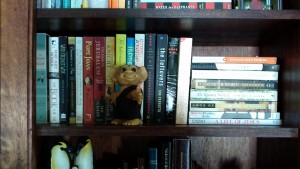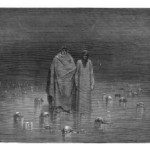From as early as I can remember, I had an invisible butler. My mother enjoyed laying my clothes out for the next day when I went to bed, but every  once in a while it was clear that someone else was stepping in to take care of my sartorial needs. I would wake up with unmatched socks laid out, or two shirts but nothing for the waist down, or no underwear, or shoes but no socks. Not wanting to insult my mother, I asked my father what was going on. “Oh, that’s your invisible butler,” he said. “Fancher Offenhowser Bullsmith.” “Since when have I had an invisible butler?” “Since he just showed up one day.” “How come I’ve never seen him?” “Because he’s invisible.”
once in a while it was clear that someone else was stepping in to take care of my sartorial needs. I would wake up with unmatched socks laid out, or two shirts but nothing for the waist down, or no underwear, or shoes but no socks. Not wanting to insult my mother, I asked my father what was going on. “Oh, that’s your invisible butler,” he said. “Fancher Offenhowser Bullsmith.” “Since when have I had an invisible butler?” “Since he just showed up one day.” “How come I’ve never seen him?” “Because he’s invisible.”
It’s kind of cool but very unusual to have an invisible butler. My brother and mother—along with my father, of course—knew about it, but I didn’t tell anyone else. No one in first grade mentioned having an invisible butler, and I had already learned that I was different enough from my colleagues in school to negate the necessity of telling them about Fancher. He didn’t seem to work regular hours; I became suspicious when I put two and two together and realized that evidence of Fancher’s handiwork only showed up when Dad was home.  But then at Christmas when I was five or six, amidst the usual paraphernalia under the Christmas tree was something entirely unexpected. Fancher had become visible. Not only did I now have a visible butler, but my butler was a troll.
But then at Christmas when I was five or six, amidst the usual paraphernalia under the Christmas tree was something entirely unexpected. Fancher had become visible. Not only did I now have a visible butler, but my butler was a troll.
Trolls have little cache these days—they are so stupid in the movies that they get turned into stone in “The Hobbit” by the rising sun, they fight on the wrong side of every fantasy epic battle, and they lurk on the Internet in order to mess up as many serious conversations as possible. But it wasn’t always that way. In the early 60s trolls were the thing.  The story of Thomas Dam, the Danish fisherman’s son who started carving trolls out of wood in the 1930s to support his impoverished family can be found on-line:
The story of Thomas Dam, the Danish fisherman’s son who started carving trolls out of wood in the 1930s to support his impoverished family can be found on-line:
http://www.damworld.dk/9986264
By the time the early 60s came around, Thomas Dam’s “Good Luck Trolls” were being machine produced to satisfy increasing demand and burst onto the international scene. Everyone wanted one. Soon there were cheap knock-off imitations everywhere, something that the Thomas Dam website warns against.
According to old fairytales trolls have magic powers. They love to make you smile and be happy. Some people say that Trolls also bring good luck. But be careful: only the ORIGINAL Dam Troll has magic powers. Therefore…look for the Dam logo and thereby be certain that you have the ORIGINAL GOOD LUCK TROLL.
Not to worry—Fancher has “Thomas Dam” stamped between his shoulder blades and “Made in Denmark” imprinted on the back of his neck. He’s an original. I apparently could get $200-$700 for Fancher on Ebay, depending on how close to mint condition he is, but that ain’t happening. He is my now retired butler, and he isn’t close to mint condition.
In case you are becoming more and more worried about my family’s and my sanity, let me assure you that I can recall no moment at which I believed that Fancher was alive or could do anything other than stand pleasantly smiling with his arms outstretched wherever I placed him. Invisible friends who suddenly become visible are fun, just as long as you don’t cross to the other side and start thinking that they are real.
This is a point that those proclaiming atheism love to make on a regular basis. Yet there are billions of human beings who shape their whole reality and might even stake their lives on the premise that a certain invisible friend not only exists but plays an exceptionally important role in our understanding of ourselves and the reality we find ourselves in. I happen to be one of those billions of human beings. So have I simply transferred my childhood connection to my invisible butler to a far more interesting and complex imaginary friend who is no more real than Fancher?  Didn’t a text supposedly inspired by this cosmic imaginary friend suggest that when one becomes an adult, one is supposed to put away childish things?
Didn’t a text supposedly inspired by this cosmic imaginary friend suggest that when one becomes an adult, one is supposed to put away childish things?
So how do we gather evidence for the existence of something? When is it appropriate to believe in something whose existence you have not verified in the usual, direct sensory ways? This issue often arises in philosophy classrooms. When it does, I ask my students How many of you believe in the existence of Mongolia? All hands go up. How many of you have ever been to Mongolia? No hands go up. Then how do you know that Mongolia exists? My students generally provide a number of sensible reasons:
- Because I have read about Mongolia in a book or on-line in stories written by people who have been there (although the authors of these sources might be lying).

- Because I have seen pictures of Mongolia (even though we know that pictures can easily be misidentified or photo-shopped).
- Because someone I know has been to Mongolia and told me about it (although this trusted source might be bullshitting me just for the fun of it).
The purpose of the exercise is to demonstrate that we believe in the existence of thousands of things that we have not experienced directly. The testimony of others, although not perfect or entirely reliable, serves as a reasonably solid foundation for much of what we believe. Life is too short and human capabilities are too finite to limit our existential belief commitments to only those items that we have experienced directly ourselves.
For many, belief in the existence of what is greater than us—what some dismiss as an “imaginary friend”—begins in exactly the same way. The sacred texts of the great monotheistic religions are accounts of what people over the centuries have believed concerning the divine. This does not prove that something greater than us exists, any more than Wikipedia entries about Mongolia prove the existence of Mongolia, but they are a good place to start and there is no reason to dismiss them just because they are referring to something that we might lack direct experience of. For instance, I had believed in the existence of Notre Dame Cathedral in Paris for decades before I actually saw and experienced it for the first time a few years ago. But I doubt I would have eventually doubted its existence if I had never seen it myself. The indirect and second-hand evidence for its existence is too overwhelming. So it goes with God—it’s difficult to dismiss theism as a pervasive “imaginary friend” phenomenon when the reports are so ubiquitous.
but they are a good place to start and there is no reason to dismiss them just because they are referring to something that we might lack direct experience of. For instance, I had believed in the existence of Notre Dame Cathedral in Paris for decades before I actually saw and experienced it for the first time a few years ago. But I doubt I would have eventually doubted its existence if I had never seen it myself. The indirect and second-hand evidence for its existence is too overwhelming. So it goes with God—it’s difficult to dismiss theism as a pervasive “imaginary friend” phenomenon when the reports are so ubiquitous.
But there’s nothing better than direct encounter. In my favorite book from the Jewish Scriptures, Job expresses it well. After decades of believing in God because of secondary evidence passed down over the generations, in the midst of intense pain and suffering he encounters the real deal. “My ears had heard of you,” Job says, “but now my eyes have seen you.” First person contact trumps any number of secondary sources, but does not negate those sources—it gives them new meaning and energy. How do I know that God is not a figment of my imagination? As I have often written on this blog, the best evidence of divine reality is a changed life. I can organize the story of my life around the “before and after” of that encounter spread over several months a number of years ago. I’m not interested in proselytizing or evangelization—you should believe what your own experience can support. But as the formerly afflicted man in the gospels says, “I was blind, but now I see.” That’s my story, and I’m sticking to it.
“My ears had heard of you,” Job says, “but now my eyes have seen you.” First person contact trumps any number of secondary sources, but does not negate those sources—it gives them new meaning and energy. How do I know that God is not a figment of my imagination? As I have often written on this blog, the best evidence of divine reality is a changed life. I can organize the story of my life around the “before and after” of that encounter spread over several months a number of years ago. I’m not interested in proselytizing or evangelization—you should believe what your own experience can support. But as the formerly afflicted man in the gospels says, “I was blind, but now I see.” That’s my story, and I’m sticking to it.














